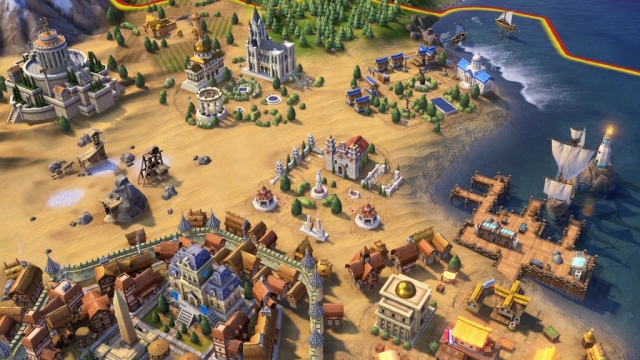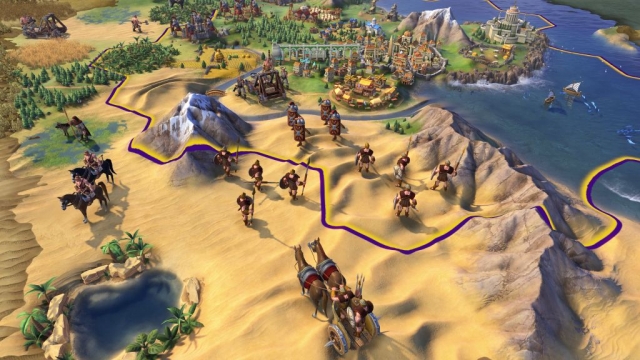Sid Meier’s Civilization VI

The Good: So much new stuff, it’s hard to discuss it all in a simple game review.
The Bad: Tutorials are kind of thin and leave much of the subtlety of the mechanics out. I predict new players will have a lot of trouble on the learning curve.
The Ugly: Nothing in particular.
I’ve played a lot of Civilization Games. I mean a lot of Civilization games. Civ (the first), Civ 2, Civ 3, Colonization, Alpha Centauri, Call to Power (which I’m not sure was actually an officially sanctioned Civ game), Civ IV, Revolution, Revolution 2, Beyond Earth, Civ V, and now Civ VI. Whew. I’ll add that even with all of those games under my belt, I consider myself only a casual Civ player. Back in grad school it was entirely common for me to play 8 or 10 hours straight, and I imagine many people still play it that way. A good friend of mine, at last check, had approaching 1000 hours in Civ V. Compared to that, I’m pretty much a piker. At any rate, among them all, Civ VI has scored something of an intellectual coup: it is the first Civ game in the whole series that I lost the first game I played. I also lost the second game. While many game reviews and reviewers will no doubt focus on the way cities sprawl in Civ VI, how many city improvements are now built outside the central city hex, as the big new change, there are so many other things going on in the minutia of the game that there are a lot of new things to learn. Some of these new things are so complicated that I’m not sure I’ll really understand them without reading the Civilopedia, which is something else that no other game in the series has driven me to do. So what are some of these new things? I’m not even sure where to begin, and keep in mind that the last time I played Civ V was right when it came out and there have been dozens of game patches and expansions since then. What I’m saying is that it is possible that some of this stuff is not new, but was baked into Civ V and I just don’t remember it or know about it. Possibly a conscientious game reviewer would go back to Civ V and check, but I’ve got a copy of Battlefield 1 on my desktop waiting for review, so this is the review you get.
Civ VI now features two tech trees – one concentrating on science and technology and the other on culture. The cultural tree covers philosophy, new forms of government, and religions – that sort of thing. As you discover cultural advancements, you apply their bonuses by placing cultural cards in a number of available civilization slots. With the variety and flavors of cultural cards in play and only a few slots to place them in, there are tremendous numbers of civilization priorities that can be juggled. There is also a cultural victory condition, which I’m pretty sure has been around for a while, and you achieve that by crossing some culture point threshold and becoming the most cultural civilization on the planet. There’s also something in there about attracting tourists, though I have no idea how that works, or what benefits you get for doing so. Something I might need to look up on the Civilopedia.
The game awards you envoys. That seems new to me. I don’t fully understand the conditions under which you are awarded envoys. Create enough trade routes, earn enough cash, every X number of cultural tree discoveries – it’s likely some combination of those things. Then you assign these envoys as ambassadors to other civilizations around you to gain insight into their cities and technology level. They kind of seem to function a little like spies if you assign enough of them to a single civilization, giving you information about their production and such, and other civilizations don’t like that, and I’ve had a couple go to war with me over no more than that (I could be wrong there, but for several turns they complained about “interfering with their government,” and then, bam!, war). Maybe I shouldn’t have assigned so many to one civilization, or maybe I shouldn’t have assigned them at all (though I don’t know what to do with them otherwise). Anyway, at the end of game two, I really have no greater understanding, the benefits/risks, of envoys than I did when I started.
You can now assign districts outside your city center. This might be almost as significant as the city unstacking thing, which I haven’t described yet. Districts are broken down into, for example, military and commercial. So a barracks built in a military district, and military units fortifying a military district gain combat bonuses. Commercial districts give bonuses for, duh, commerce, and there are other districts that provide research and cultural bonuses. I know I used the word assign earlier for how districts are created, but really they’re more built – they come out of the ordinary city production queue, and there are all kinds of rules about where they can be built about which I have almost no idea, but thankfully the game highlights the permitted hexes when you go to build one or I would never get it right.
And, yes, much as Civ V unstacked military units (in doing so putting an end to the stacks of death), Civ VI unstacks the city construction. I mean, some elements of Civ cities have always been unstacked – I recall fields and mines have been in the surrounded hexes perhaps going all the way back to Civ 1. Only now, while some city improvements still reside within the city proper (I’m not 100% certain of which, but I believe granaries are still inside as are aqueducts), others must be built in the surrounding land (barracks, churches, universities, banks maybe, and all civilization wonders are outside). From a military perspective, protecting all of these external structures is kind of a pain, and early on barbarians can really throw a wrench into your plans as they loot and destroy civilization improvements while you either try and chase them down with limited units, or delay some other facet of your civilization growth while you churn out enough units to protect everything.
There is so much new and complicated stuff going on in this iteration of the series. To be blunt, I’m not sure how I feel about Civilization VI which, and I’m sure some will disagree with this assessment, is less approachable than others in the past. I believe Civ VI to be less intuitive, and the curve of civilization advancement is steep enough that, with just a few dozen turns of trial and error as you try and figure things out at critical moments, is going to ultimately set you on a path that will cost you the game. This doesn’t make Civ VI a bad addition to the series. Indeed, I think it is a very good addition with much that fans of the series will love. But that vision of Sid Meier, that each new Civ game will feature “one-third old stuff, and one-third improved stuff, and one-third new stuff,” to appeal to new players as well as veterans – I think this game fails in that regard. The era of new players, people who have never touched a Civ game suddenly coming to the series, that’s in the past, much like no one is going to be able to start Game of Thrones with season six or pick up as their first physics textbook Advanced Quantum Electrodynamics (a real subject, and the title of a book on my shelf at this moment). There’s too much baggage, too many things you’ll never figure out unless you’re willing to lose your first two hundred games to do so. I’ll stick with it (if I have time among my other game reviewing duties), but I wouldn’t blame a new player for becoming frustrated and tuning out.
Reviewed By: Phil Soletsky
Publisher: 2K Games
Rating: 90%
——————————————————————————–
This review is based on a digital copy of Sid Meier’s Civilization VI for the PC provided by 2K Games.
 Game Over Online
Game Over Online
















